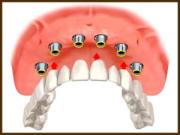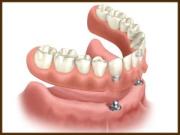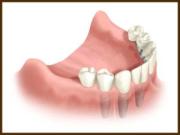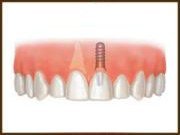Dental Implants
What is an implant?
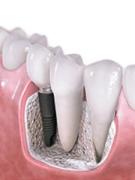 Dental implants are replacement tooth roots. Implants provide a strong foundation for fixed (permanent) or removable replacement teeth that are made to match your natural teeth.
Dental implants are replacement tooth roots. Implants provide a strong foundation for fixed (permanent) or removable replacement teeth that are made to match your natural teeth.
What Are the Advantages of Dental Implants?
- Improved appearance. Dental implants look and feel like your own teeth. And because they are designed to fuse with bone, they become permanent.
- Improved speech. With poor-fitting dentures, the teeth can slip within the mouth causing you to mumble or slur your words. Dental implants allow you to speak without the worry that your teeth might slip.
- Improved comfort. Because they become part of you, implants eliminate the discomfort of removable dentures.
- Easier eating. Sliding dentures can make chewing difficult. Dental implants function like your own teeth, allowing you to eat your favorite foods with confidence and without pain.
- Improved self-esteem. Dental implants can give you back your smile and help you feel better about yourself.
- Improved oral health. Dental implants don’t require reducing other teeth, as a tooth-supported bridge does. Because nearby teeth are not altered to support the implant, more of your own teeth are left intact, improving your long-term oral health. Individual implants also allow easier access between teeth, improving oral hygiene.
- Durability. Implants are very durable and will last many years. With good care, many implants last a lifetime.
- Convenience. Removable dentures are just that; removable. Dental implants eliminate the embarrassing inconvenience of removing your dentures, as well as the need for messy adhesives to keep your dentures in place.
What Are The Types of Dental Implants?
- Root Form Implants :
Root form implants are the closest is shape and size to the natural tooth root. They are commonly used in wide,deep bone to provide a base for replacement of one, several or a complete arch of teeth. After application of anesthetic, your dentist will expose the area of the jawbone to be implanted and prepare the bone to accept the implant. The number of incisions and bone preparations depends upon the number of implants (and teeth) being placed. The implant is carefully set into place and the gums are closed with several stitches. The healing period usually varies from as few as three months to six or more. During this time osseointegration occurs. The bone grows in and around the implant creating a strong structural support. In fact, this bond can be even stronger than the original tooth’s. When healing is complete, your implant is uncovered and an extension or abutment is attached to it. Now the implant and abutment act as a solid unit ready to support your new tooth or teeth.
- Plate Form Implants :Plate form implants are usually used when the bone is so narrow it may not be suitable for the root form implant and the area is not suitable for bone grafting. The plate form implant is flat and long so it can fit into the narrow jawbone. After application of anesthetic, your dentist will expose the area of the jawbone to be implanted and prepare the bone to accept the shape of the implant. The number of incisions depends upon the number of implants being placed. The implant is carefully set into place and the gums are closed with several stitches. Like root form implants, there is usually a healing period for osseointegration, although some plate form implants are designed for immediate restoration.
- Subperiosteal Implants :
With very advanced jawbone resorption there may not be enough bone width or height for the root form or plate form implant. In these cases the subperiosteal implant may be prescribed. The subperiosteal implant is custom made and designed to sit on top of the bone, but under the gums. There are two methods for its placement.The “dual surgery” method. After application of anesthetic, your dentist will expose the jawbone and take an impression or model of the bone using special materials. This model is used by a dental laboratory to carefully create the custom implant to fit your jaw. A second procedure is then carried out where the jawbone is exposed and the implant placed. The gums are closed with several stitches and replacement teeth are put into place.For the “single surgery” method your dentist will order a special CAT scan of your jawbone. Using the CAT scan data and advanced computer modeling techniques, a model of your jawbone is constructed. This model is used by a dental laboratory to fabricate the custom subperiosteal implant to fit your jaw. A surgical procedure is then carried out where the jawbone is exposed and the implant placed. The gums are closed with several stitches and the replacement teeth are put into place.
FAQ about Implants
How Successful Are Dental Implants?
Success rates of dental implants vary, depending on where in the jaw the implants are placed but, in general, dental implants have a success rate of up to 98%. With proper care (see below), implants can last a lifetime.
Can Anyone Get Dental Implants?
In most cases, anyone healthy enough to undergo a routine dental extraction or oral surgery can be considered for a dental implant. Patients should have healthy gums and enough bone to hold the implant. They also must be committed to good oral hygiene and regular dental visits. Heavy smokers, people suffering from uncontrolled chronic disorders – such as diabetes or heart disease – or patients who have had radiation therapy to the head/neck area need to be evaluated on an individual basis. If you are considering implants, talk to your dentist to see if they are right for you.
What Is Involved in Getting a Dental Implant?
The first step in the dental implant process is the development of an individualized treatment plan. The plan addresses your specific needs and is prepared by a team of professionals who are specially trained and experienced in oral surgery and restorative dentistry. This team approach provides coordinated care based on the implant option that is best for you.
Next, the tooth root implant, which is a small post made of titanium, is placed into the bone socket of the missing tooth. As the jawbone heals, it grows around the implanted metal post, anchoring it securely in the jaw. The healing process can take from 6 to 12 weeks.
Once the implant has bonded to the jawbone, a small connector post – called an abutment – is attached to the post to securely hold the new tooth. To make your new tooth or teeth, your dentist makes impressions of your teeth, and creates a model of your bite (which captures all of your teeth, their type, and arrangement). Your new tooth or teeth are based on this model. A replacement tooth, called a crown, is then attached to the abutment.
Instead of one or more individual crowns, some patients may have attachments placed on the implant that retain and support a removable denture.
Your dentist also will match the color of your new teeth to your natural teeth. Because the implant is secured within the jawbone, the replacement teeth look, feel, and function just like your own natural teeth.Are implants always successful?
Modern implant techniques have been in use since the 1950’s. Improvements in procedures and materials have given implants a ten year average success rate of 93 percent or better. This enviable success rate is improving every year!
What factors contribute to long-term success of Dental Implants?
Long-term success depends on multiple factors. First off, success will depend on the quality and quantity of bone. The better the bone and the more available, the greater the chance of long-term success. Secondly, the experience and ability of the dental surgeon will be a factor. As with any surgical procedure, there is no substitute for the experience and individual talent of the dentist. And finally, the quality of the restoration placed on top of the implant will play a big role in long-term success. If the design of the implant crowns or overdentures are poorly constructed, and biting forces are not balanced, even the best-placed dental implant will have a compromised survival rate.
Are there any age limitations for dental implants?
No. Any person at any age can have dental implants as long as there is enough bone available in which to place the implants.
How often will I need to have my dental implants checked?
The success of your implants will depend greatly on how well you maintain them. They will need to be professionally cleaned by a hygienist and examined by your implant dentist every three to four months. This hygienist should be trained in the specific procedure of maintaining dental implants. Also, brushing and flossing daily is absolutely necessary for long-term success.
What can go wrong with dental implants?
There are really not too many things that can go wrong with dental implants. They can fail to integrate into the bone and come out. They can fracture or break. There can be problems with the connection between the implant and the prosthesis. There can be an infection or an inflammatory condition in the soft tissue and sometimes in the bone as a result of the implant placement. There can be damage to the nerves in the lower jaw and there can be damage to the maxillary sinus or the nasal cavity. All of these complications are rare and usually account for less than 5% of all dental implant treatments. These complications can usually be easily corrected.
Can failed implants be replaced?
In the unlikely event an implant fails it can usually be replaced by another. In fact, most patients wouldn’t have it any other way!
How long after a dental implant is placed can it be used to anchor my new teeth?
The protocol that was originally developed clearly states that we must wait three months in the lower jaw and six months in the upper jaw before we can begin to construct the new dental prosthesis that will be supported by the implants. In recent years, however, there has been a movement within the profession to sort of speed up this process. Today we believe that it is possible in selected patients to accelerate the healing time. We are even loading implants in very specific situations right away. However, the general protocol that I favor is 3 months in the lower jaw and 4 months in the upper jaw.
Will others know I have dental implants?
Today’s implant treatment enables you to have your new teeth look, feel and function like your own. Even though others will be unaware you have dental implants, many patients are so pleased they tell everyone they know. Dental implants offer some of the finest restorative results possible in modern dentistry.
How long does complete treatment take?
Depending of the type of implant and replacement teeth selected, the total time can be as little as a few weeks to six or more months. If bone grafting is necessary, further time may be needed. Your dentist will discuss your options with you and advise you of the time requirements.
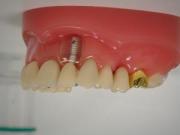 Will I need to be hospitalized?
Will I need to be hospitalized?
Most implant procedures are performed in the dental office under local anesthesia. Although, some patients may desire pre-medication or IV sedation to control apprehension. Hospitalization may be necessary for complex surgical procedures or general health reasons.
Is there pain or discomfort?
Most people who have received dental implants say that there is very little discomfort involved in the procedure. Local anesthesia can be used during the procedure, and most patients report that implants involve less pain than a tooth extraction.
After the dental implant, mild soreness can be treated with over-the-counter pain medications
Will I be without replacement teeth at any time?
Immediately following surgery you may be instructed not to wear replacement teeth in the surgical area. If required, this period is usually short, and temporary teeth are soon provided so you can quickly “get on” with your life.
How much does implant treatment cost?
The cost of implant treatment depends upon the number and type of implants placed and the type of replacement teeth needed. For example, replacement of a single tooth with implant treatment costs about as much as a dental bridge. The bridge necessitates “cutting down” adjacent teeth for crowns. Implant treatment does not. More complex treatment, such as bone grafting, will add to the cost. The cost can vary in different countries, so it’s is best to consult your dentist. The improvement in your self confidence, comfort, eating habits and appearence will make dental implant treatment one of the best investments you’ve ever made!
Are implant supported teeth as strong as my natural teeth?
Yes. Research shows that in many cases implants are actually stronger then natural teeth. Compared to removable teeth, studies show implant supported teeth have 100 percent or better chewing efficiency. Dental implants can make it possible for you to enjoy your favorite foods, improve your nutrition and your appearance!
How Do I Care for Dental Implants?
Dental implants require the same care as real teeth, including brushing, flossing, and regular dental check-ups.
What are the types of the prothesis that are planned on implants?
-
Implant-supported prosthesis (removable)The implants are positioned just below the gum tissue and given time to fuse with the bone. Temporary abutments may be placed on the implants until the healing phase is complete. Your existing denture can be modified so that it may be worn without disturbing the implants during the healing process.You will be fitted for a custom-made bar that attaches to the implants to support a new denture. Your existing denture may be modified to be worn during this period.The new denture will have attachments which snap or clip it into place. Your new teeth are firmly supported by the jaw, stimulating it and halting bone loss. You will be able to remove the denture easily for cleaning.
-
Implant-supported prosthesis (Fixed)
If all your lower or upper teeth are missing, a permanent bridge may be attached directly to the implants. The number of implants is determined by the specific requirements of each case.After the implants are fused with the bone,you will be fitted for a custom bridge that screws directly into the implants. The screw holes will be covered after insertion.Your new teeth are firmly supported by the jaw, stimulating it and halting bone loss. Your dentist will be able to remove the prosthesis when necessary for cleaning and maintenance. Temporary abutments may be placed on the implants until the healing phase is complete. Your existing denture may be modified so that it can be worn without disturbing the implants during the healing process.
-
Implant-stabilized denture
If all your lower teeth are missing, two to four implants may be used to stabilize a lower denture.Dental implants can provide stability to your existing loose denture.After healing, ball-top posts are attached to the implants. Your old denture may be modified to hold clips that snap over the ball-tops, or a new denture with clips will be made.The denture is snapped into place, where it is retained by the implants and supported by the soft tissue. You simply snap the denture out each night for cleaning.
Do we need implants for every missing tooth?
No if there are more than 1 missing tooth sometimes considering the mechanical con sept and esthetic demands lesser implants can be inserted
What if osseointegration does not occur?
If properly preplanned and surgically and prosthetically well designed and execute the possibility for a disosseointegration is almost neglectable .This kind of failure often occurs in the first 3 monts period. If something like that happens then like a simple extraction the implant is taken out eather the site is grafted for a later implantation or if there are remaining implants intact anew prosthesis is plannes to go on with the rest of the implants.Or in case nothing can be done a conventgional prosthesis can be accomplished.
Who should you see about dental implants?
The question is really who should you see about getting missing teeth replaced? Before implants, you went to either your general dentist or, if you wanted a specialist, to a prosthodontist. It’s the same today. If you want to replace missing teeth, talk to the people who do that job and they will be glad to discuss the use of dental implants in that process. If you decide that dental implants are for you, then your general dentist or prosthodontist can either place the implants for you or refer you to a qualified surgeon, usually either an oral surgeon or a periodontist, for that phase of the treatment. In the consultation with your preferred dentist a detailed medical history of yours including clinical and radiological exams (sometimes ct scans) are recorded and evaluated to determine whether your case is indicated for implant therapy.In conjunction with different diagnostic tools pictures and models obtained from your jawws are also a great help for the final decision.
What can go wrong with implants?
There are really not too many things that can go wrong with dental implants. They can fail to integrate into the bone and come out. They can fracture or break. There can be problems with the connection between the implant and the prosthesis. There can be an infection or an inflammatory condition in the soft tissue and sometimes in the bone as a result of the implant placement. There can be damage to the nerves in the lower jaw and there can be damage to the maxillary sinus or the nasal cavity. All of these complications are rare and usually account for less than 5% of all dental implant treatments. These complications can usually be easily corrected.
However, in recent years, especially in my role as an expert witness, I have seen some extreme situations where dentists who were poorly trained in these techniques have caused major problems for their patients. The patient must always seek out experienced practitioners to perform this kind of work to insure proper results.
What are pros and cons of implants in these spesific cases?
-
- People who lost all lower teeth and using dentures : These patient suffer most of the time from soar and discomfort while eating due to the use of removable denture. this phenomenon gets worse as the bone resorbtion underlying the prosthesis gets more extreme.In those cases implants tat will give support to the dentures not only will solve the problem of unstable dentures but will stop further bone resorbtion by stimulating the residuel bone as well..
- People who lost all upper teeth and using dentures : Although looking from stability point of view the upper prosthesis is more stable the lack of taste due to thga extension till the soft palate gives discomfort to the patient.
- People who lost some of their lower and upper teeth : For these patients the unesthetic appearance of the clasps and retainers of the partially removable prosthesis or the need of tooth preparation adjacent to missing teeth in order to do fixed bridges can be counted as disadvantages.
- People who lost only one tooth: Conventionally to restore the space of one missing toot two adjacent teeth need to be prepared for a fixed bridge. By utilizing implant therapy those two teeth remain untouched and esthetically and functionally more relevant option is obtained.
What are some of the benefits of dental implants?
- They look and feel just like your own teeth. Dental implants restore your confidence to talk, laugh, and chew with comfort and without worries.
- Implants preserve the integrity of facial structures. Implants prevent the hard and soft tissue collapse that can occur under conventional bridges and removable partial dentures. In patients who have lost all of their teeth, the lower one-third of the face is prone to collapse if implants are not placed to preserve the bone and the facial profile. Implants form a strong bond to the surrounding bone to provide support and anchorage for biting and chewing as well as stimulation for the bone to hold it in place.
-
Implant-supported crowns and bridges do not require neighboring teeth for support. When teeth are replaced using traditional tooth-supported bridges, the teeth on either side of the missing tooth are ground down so that the bridge can be cemented onto them This tooth structure can never be replaced. Removable partial dentures use clasps and rests which have to be carved onto adjacent teeth. As the partial rocks back and forth, it can loosen the teeth it depends on for anchorage, causing them to be lost.
-
Implants replace the entire tooth and the missing root so it is a free-standing restoration. This leaves more of your natural teeth untouched and free of restorations which saves your natural teeth.
-
Better health and nutrition because you can eat what you want. Patients with dentures often find themselves unable to eat certain foods, such as fruits and vegetables, which can compromise their nutrition. With dental implants, it is much easier to bite into and chew your favorite foods.
-
Ease of cleansing. An implant supported crown can be cleaned like your other natural teeth, i.e. brushing and flossing. Cleaning under a bridge, however, requires the use of floss threaders for proper cleaning, while a partial must be taken out several times a day and scrubbed clean.
-
Enjoy your food. Patients who wear an upper denture often have trouble really tasting food because the roof of the mouth is covered. With implant supported replacement teeth, it is not necessary to cover the roof of the mouth, so it is possible to enjoy the taste of all your favorite foods.
How long do implants last?
Published clinical research shows that implant supported restorations have been successful for over 30 years with success rates now reaching over 95%. These cases were carefully followed from the very beginning and are likely to remain successful for the lifetime of these patients.
Dental implants are designed to be permanent but there are many factors that contribute to their longevity. Home care and regular visits to the dentist or specialist are probably the most critical aspects. However, smoking, grinding of the teeth, or too much pressure on the implants can alter their success.
By comparison, research shows that the typical tooth supported bridge lasts from 7-10 years and that partials and dentures last an average of only 5 years. In fact, insurance companies expect that bridges, partials, and dentures will last 5 years and will therefore pay for replacements every 5 years.I
Is age a contraindication for implants ?
No contrary to what is thought about it age factor is almost neglectable since the overall health conditions play a much more important role. Ansd considering that older people have more missing teeth than younger ones implants are the right indication for people even over 70-8 years unless they show good oral and general health conditions which allow for implant placement.Younger people like children have better to wait until all the bone development is finished between18-2 to get implants.Till then they have to be supplied with other conventionel methods.
Are there any risks for rejection of the dental implant?
Today titanium and titanium alloys with different catings are the materials of choice for dental implants.Titanium and its alloys are used in general medicine for quite a long time especially by orthopedists for hip replacements etc. and have proven themselves to be a noninert material which can be safely used in body. But of course there is a very slight risk that has to be encountered as it is with every material that may cause foreign body reaction.The lately very popular zirconiumoxite is onother material the componies are working on as a possible titanium substitute which are nowadays not widely used. .
Are there any risks for cancer?
In the medical literature there is no paper which adresses the risk of causing cancer for implants
Implant success rate is dependent on:
- The oral hygiene before and after the implant therapy ,
- The alcohol and cigarette intake during the the healing period ,
- The good overall health conditions (Diabetes that is not under control may interfere with healing),
- A nonseptic sterile good surgical protocol,
- Good treatment planning.
How long does it take to insert an implant?
This is very much related to your oral condition ,to your needs and to the procedure that is going to be done.Technically to place an implant generally takes approximatelly 10 minutes.But if there are more than one implants to be inserted an/or if extra interventions like bone augmentation or sinus augmentation procedures have to be done it takes longer.Sometimes implants are placed with a one stage approach which needs only one surgery whereas sometimes with a double surgery approach you may need to do a second stage surgery,which has to be kept in mind.
How many days do I have to take off?
Generally we recommend the day of the surgery and the day after to rest,since there may be some swelling ,pain and in the longer surgeries some broozing as well which disappear in a few days.But with new surgical techniques which utilize 3 dimensional planning the surgery is much more facilitated and the after affects are reduced in favour of the patient.

